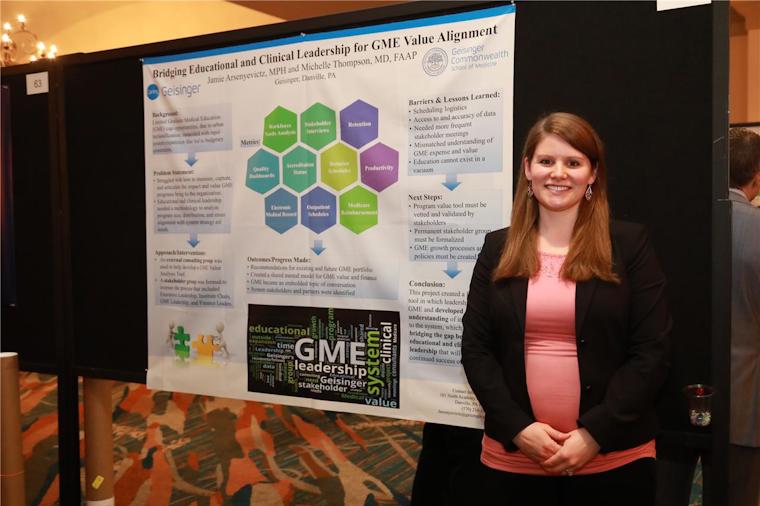Jamie Arsenyevictz, MPH, led a team at Geisinger Health System to develop a GME analysis tool, leading to the development of shared language and knowledge surrounding GME finance and value between the GME Office and Geisinger leadership.
Poster: Bridging Educational and Clinical Leadership for GME Value Alignment
Author: Jamie Arsenyevictz, MPH
ACGME: Tell us about your academic and professional role.
Arsenyevictz: In my role as the Manager of Medical Education, I am responsible for accreditation oversight, operational leadership, and staff oversite and support for the Geisinger GME programs. I also serve as the co-chair of Geisinger’s GMEC. I received my Bachelor’s degree from DePauw University in Greencastle, Indiana, and my Master’s in public health from Indiana University in Bloomington, Indiana. I am a recent graduate of the AAMC GME Leadership Development Certificate Program.
ACGME: Can you briefly describe your project for us?
Arsenyevictz: Geisinger solicited an external consulting group to help develop a GME Value Analysis tool. An internal stakeholder group was formed to oversee the process, which included representatives from executive leadership, institute Chairs, finance leaders, and GME leadership. A variety of metrics were examined for each GME program, which helped inform the GME Value Analysis. The consulting group then made recommendations for existing and future GME programs. Through this project, a permanent GME stakeholder group that has the authority for prioritizing GME decisions related to system need and strategic plans was formalized. This group created a clear process related to GME growth within Geisinger.
ACGME: What inspired you to do this project?
Arsenyevictz: Historically, educational leadership has struggled with how to measure, capture, and articulate the impact and value GME programs bring to the organization (i.e., physician recruitment and retention, patient access, service coverage, educational value, etc.). Educational leadership has also not had consistent input with executive leadership to discuss how GME fits into system strategy. Geisinger needed both a venue for the discussion to occur and a methodology that allows for educational and clinical leadership to analyze program size, distribution, and ensure alignment with system strategy and the healthcare needs of the communities served by Geisinger.
Geisinger’s largest hospital, Geisinger Medical Center (GMC), was historically designated by Medicare as a rural hospital and was recently reclassified as urban, thus limiting the potential for new GME growth. Historically, GMC could expand GME programs based on clinical department’s desires instead of purposeful strategic plans based on program value and system priorities. The urban reclassification coincided with rapid system expansion leading to increased educational opportunities for GME at a time when the system was experiencing budgetary constraints. This situation highlighted the need to develop a methodology to ascertain the value of existing GME programs and develop a shared governance for decisions regarding growth and expansion.
ACGME: What did you discover?
Arsenyevictz: Recommendations were presented to an expanded stakeholder group that included representation from Geisinger’s executive leadership, platform leadership, and all clinical institutes. The conversations led to the development of shared language and knowledge surrounding GME finance and value, creating a shared mental model between educational and clinical leaders. This focus on GME extended beyond the stakeholder group, with conversations occurring in all clinical areas. For the first time, educational leadership has begun to identify true system stakeholders and partners that are engaged in the development of a GME system strategy.
ACGME: What was the main takeaway?
Arsenyevictz: The presence of an outside consulting firm provided legitimacy and weight to the conversation that historically was not uniformly recognized. For the first time, there was a strategic, purposeful, and organized forum in which Geisinger leadership discussed GME, developed a shared understanding of its importance to the system, and had authority to make decisions. The consultants provided an objective assessment of GME in a timeframe that would have otherwise been unattainable. With continued system growth and ongoing requests for GME expansion, creation of a forum and tool to evaluate Geisinger’s GME portfolio and prioritize program growth and expansion was vital. This project was responsible for bridging the gap between educational and clinical leadership that will allow the continued success of GME at Geisinger.
ACGME: Who could benefit from this?
Arsenyevictz: DIOs, GME directors/managers, and anyone else in GME leadership.
ACGME: Any additional follow-up plans?
Arsenyevictz: The GME Value Analysis tool continues to be vetted and validated by educational and clinical stakeholders. Geisinger is still working on how to streamline the data gathered by the consulting group so that it can have real time data on each of the programs related to the various metrics that impact GME value.

